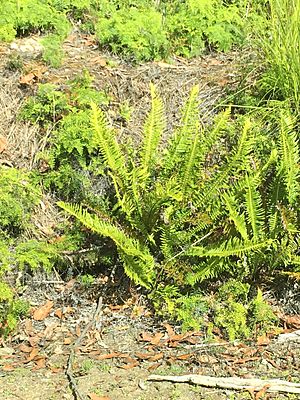Fishbone water fern facts for kids
Quick facts for kids Fishbone water fern |
|
|---|---|
 |
|
| Scientific classification | |
| Synonyms | |
|
The fishbone waterfern (also known as Lomaria nuda or Blechnum nudum) is a type of fern that can grow quite tall, sometimes up to a metre! You can find lots of these ferns growing in rainforests and eucalyptus forests in eastern Australia.
Contents
About the Fishbone Waterfern
What it Looks Like
The fishbone waterfern has long, flat leaves called fronds. These fronds usually grow to be about 40 to 60 centimetres long. Each frond has a short, thick stem at its base, which might have tiny hairs on it.
Ferns in the Blechnum family, like the fishbone waterfern, have two different kinds of fronds:
- Sterile fronds: These are the regular fronds you see. They look delicate and have a thinner, longer stem. The longest parts of these fronds are in the middle, getting shorter towards the ends.
- Fertile fronds: These fronds are special because they produce spores, which are like tiny seeds for ferns. They can grow even longer than the sterile fronds. The parts of these fronds are thinner and more rounded, curving towards the tip.
How it Grows and Spreads
The fishbone waterfern has a life cycle typical of most ferns. However, a cool thing about Blechnum ferns is that they have separate fronds just for making spores. While many ferns can make spores on any of their fronds, Blechnum species have special fertile fronds for this job.
Besides making spores, the fishbone waterfern also spreads in another way. It grows through an underground stem called a rhizome. This rhizome spreads out under the ground, and new fronds pop up from it. Over time, one fern plant can spread its underground stems over a large area. This way of growing, without spores, is very common for ferns.
Where it Lives
You can find the fishbone waterfern in all Australian states except Western Australia. Where it likes to grow, it's usually found in large numbers!
This fern loves wet forests. Like many ferns, it needs a lot of water to grow well. That's why you'll often see it in moist, poorly drained places. Shade is also important for the fishbone waterfern because it helps keep the ground wet.
Even if there isn't much rain, poorly drained soils help keep water in the ground for the plant. However, the fishbone waterfern can also grow in full sun if it gets enough water. This is why you might spot it growing in ditches next to roads, where sunlight is strong but water collects after it rains. Creek beds are also natural places where this fern thrives, as they have plenty of water even when it's not raining much.
So, the best places for the fishbone waterfern are rainforests and wet eucalyptus forests. Both of these places usually get a lot of rain and have many trees that provide shade. Rich soil also helps the waterfern grow and spread widely in these forests.
How People Use It
The fishbone waterfern is a popular plant to buy at plant nurseries. People like to grow it in their gardens because it's tough and looks beautiful.
- Plant Net http://plantnet.rbgsyd.nsw.gov.au/cgi-bin/NSWfl.pl?page=nswfl&lvl=sp&name=Blechnum~nudum retrieved 13 March 2017
- dpipwe https://web.archive.org/web/20160323101808/http://Quarantine.Enquiries@dpipwe.tas.gov.au/Documents/Blechnum-nudum-Notesheet.pdf retrieved 2017-03-17
- Gardens Online http://www.gardensonline.com.au/GardenShed/PlantFinder/Show_1651.aspx retrieved 2017-03-17


